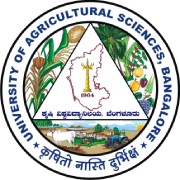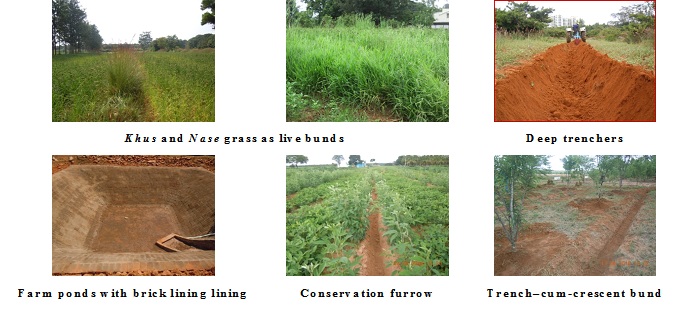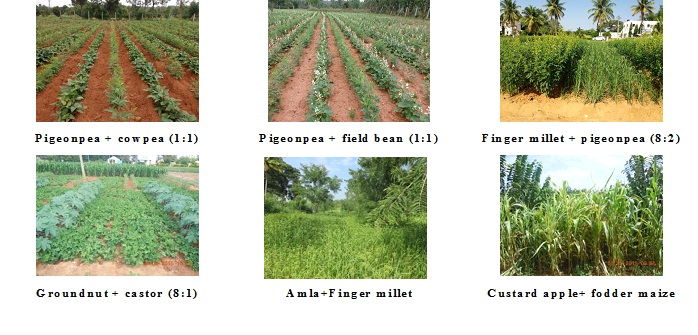

| AICRP Scheme/Unit : AICRP for Dryland Agriculture | ||||||||||||||||||||||||||||||||||||||||||||||||||||
| Location : UAS, GKVK, Bangalore | ||||||||||||||||||||||||||||||||||||||||||||||||||||
| Year of Start : 1970 | ||||||||||||||||||||||||||||||||||||||||||||||||||||
| Mandates :
· Optimize natural resources use (rainfall, land and water) to minimize soil & rain water loss and environmental degradation · To evolve simple technologies for sustainability, increase crop productivity and economic viability · To increase stability of crop production over years by way of improvements in natural resources and crop management systems and alternate crop production technologies matching to weather aberrations · To develop alternate and sustainable land use systems · To transfer and evaluate improved dryland technologies in the farmer’s fields |
||||||||||||||||||||||||||||||||||||||||||||||||||||
| Research Programmes :
v Sustainable dry farming practices – Rain water management, Cropping system, Soil health and crop nutrition, Alternate land use systems, farm mechanization v Demonstration of dryland technologies for changing climatic scenario v National Innovations in Climate Resilient Agriculture (NICRA) v Standardization of conservation agriculture practices for finger millet + pigeonpea (8:2) inter cropping system v Center for next generation technologies in adaptive agriculture v On Farm Research (OFR) on Rain fed Integrated farming System (RIFS) v Establishment of a Model Watershed for Resource Conservation and Capacity Building at UAS, Bengaluru v SCSP Program v Studies on post emergence application of broad spectrum herbicides and their residual effect on the productivity of field crops |
||||||||||||||||||||||||||||||||||||||||||||||||||||
| Research Accomplishments :
v The All India Co-ordinated Research Project for Dryland Agriculture (AICRPDA), Bengaluru is catering the research needs of dryland farmers of Southern Karnataka comprising of Zone- IV, Zone-V and Zone-VI v The main focus is on location specific problems considering the agro-climatic zones, predominant rainfed production systems and socio-economic situation with major emphasis on rain water management, integrated nutrient management, energy management, crops and cropping systems, contingency planning, tillage and farm machinery, drought mitigation strategies and alternate land use system v Research findings of the centre are being evaluated on farmer’s fields through Operational Research Project and National Initiative on Climate Resilient Agriculture Rain Water Management : The research accomplishments of the center include conceptualization of rainfed farming policy in the state of Karnataka under Krishi Bhagya Scheme comprising in-situ moisture conservation and ex-situ rainwater harvesting in farm pond and its efficient utilization. For effective conservation and management of rain water graded bunds and levelling of graded boarder strips in deep red soils will help to reduce the runoff losses and safe disposal of excess water, there by increased the crop yield. Apart from this Khus and Nase grass as live bunds to conserve soil and water by reducing the soil loss and runoff by 36 % in slope up to 2.5 %. Similarly vegetative barriers reduces runoff (11-12%) & soil loss (1.52-1.70 t/ha/year) as compared to control (soil loss: 2.5 t/ha/year) and helps in increasing the finger millet productivity. Also, in-situ soil moisture conservation through opening of conservation furrow improved productivity by 25-30 %. Further mulching with crop residue in chilli resulted in moisture content in soil helped in obtaining higher growth and green chilli yield (30-35%) than crop without mulching. Trench–cum-crescent bund helps in enhancing productivity and profitability by impounding water resulting in conservation of higher moisture content of dryland orchards than that of no trenches. Lining of farm ponds (brick lining and brick compartment lining) with 400-500 microns gauged LDPE (Low Density Poly Ethylene) sheet with 8:1 ratio of soil-cement plastering to 5 cm thickness mortar in brick lining 1m2 rectangular brick compartments in brick compartment lining on all the four sides of the farm pond for higher stability helps in seepage control. The recommended size of farm pond is 250 m3 per hectare catchment with 12 m × 12 m top length and width 6 m × 6 m bottom length and width with 3 m depth and 1:1 slope. Sub soiling at 2 m interval + organic manure resulted in higher productivity and profitability for three years breaking down the hard subsoil helping in high soil moisture conservation than the control.
Cropping system : · During early in the season growing of fodder pearl millet and cowpea followed by green chilli and transplanted finger millet, respectively was found to be promising double cropping system with increased yield and B:C ratio (3.55 and 3.36 respectively) over sole finger millet. · During delay onset of monsoon dry seeding of finger millet with higher seed rate (7.5 kg ha-1) in anticipation of rain within 8-10 days was found to be successful. · Practicing cereal/oil seed based inter cropping system (finger millet + pigeonpea (8:2)/ (10:2), maize + pigeonpea (1:1) and finger millet + castor (10:1)), pulse based (pigeonpea + field bean (1:1), pigeonpea + cowpea (1:1)) and oilseed based intercropping system (groundnut + pigeonpea (8:2), groundnut + castor (8:1)) and also bud nipping of castor were found to be promising by increasing the yield upto 25-30 %. · Also, alternate land use system involving finger millet and mango performed better over their respective sole crops in terms of growth and yield. · Inter cropping of amla with finger millet (1427 kg ha-1) was found to be better intercrop in amla based agri- horti system also resulting in higher net returns (₹. 29,446) than sole amla. · Inter cropping of custard apple with fodder maize (2346 kg ha-1) was found to be better intercrop in custard apple based agri-horti system also resulting in higher net returns (₹.1,19,672) and B: C ratio (6.67) than sole custard apple.
Integrated nutrient management : · Integrated nutrient management viz., application of FYM @ 10 t/ha with 100 % NPK resulted in sustained finger millet productivity and soil health with a mean productivity of 1.8 t/ha. · Ex-situglyricidia green leaf manuring to supply 50 % N +100 % PK improved finger millet yield and also 50 % N through green leaf manure and 50 % NPK in finger millet – soybean-maize rotation system resulted in higher finger millet (3004 kg/ha), maize (2790 kg/ha) grain yield as compared to application of Rec. NPK (2572 kg/ha, 1150 kg/ha, respectively). · Among secondary nutrients application of calcium through lime to 45 % Ca saturation level (300-400 kg/ha of agriculture lime) + Rec. NPK (25:50:25 kg/ha) to Alfisols improved the productivity of groundnut (1625 kg/ha) with a B: C ratio 2.5. · Application of sulphur @ 10 kg/ha in cowpea, black gram, sunflower and groundnut increased seed yield (1350, 1160, 1230 and 2000 kg/ha, respectively) as compared to control. · Application of higher dose of potassium (37.5 kg ha instead of 25 kg/ha) increased the yield in finger millet (3.5-3.9 t/ha) · Application of potassium @ 20 kg ha-1 in little millet and foxtail millet resulted in higher grain and straw yield of 730, 1282, 856 & 2063 kg ha-1 respectively. · Application of zinc and boron along with NPK increased seed yield by 15-21 % in finger millet, 8-31 % in pulses and 15-37 % in oil seeds over farmers practice. · Crop rotation with legumes resulted in higher yield of finger millet. · Mixing of finger millet seeds with complex fertilizers like DAP gives higher grain yield 2460 kg/ha and B: C ratio 2.11 as compared to broadcasting method. · Band placement of phosphatic fertilizer below the seed line resulted in higher grain yield of 5210 kg/ha compared to broadcasting (4690 kg/ha), especially in widely spaced crops like maize.
Participatory Varietal Selection/ Crop Improvement : · Sowing suitable finger millet varieties (Long duration: MR-1, MR-6, Medium duration: GPU-28, KMR-301 and Short duration: GPU-28, KMR-316, ML-365) depending upon onset of monsoon is important contingent crop plans for aberrant weather and these promising varieties resulted in higher yield and also reduces risk of crop failure. · Among pulses improved varieties in horse gram variety (PHG-9), pigeonpea (BRG- 1, BRG-2 and BRG-5), field bean (HA-3 and HA-4) and vegetables cowpea (IT-38956-1, PKB-4 and PKB-6) were promising varieties as compared to local cultivars. · Among different oilseed crops improved high yielding varieties of groundnut (JL-24, Chintamani-2, ICGV-91114 and GKVK-5), sunflower, (KBSH-44 and KBSH-53), sesame (TMV – 3), Niger (KBN-1 and KBN-2) and castor (DCS-9) were found to be promising under dryland condition. · Samrudhia high yielding chilli variety was found to be promising for green chilli purpose and recorded 30% higher yield as compared to local varieties.
Energy Management : ·Tractor drawn deep tillage equipment like disc plough, mould board plough and chisel plough conserves more moisture in the lower strata of soil and helps in better growth, yield of maize and pigeonpea · In-situ green manure incorporation through tractor drawn rotovator (covers one hectare in 90 minutes) resulted in higher yield (32.6 %) with reduction in 50-60 % energy costs. · Tractor drawn post hole digger helps in reducing the cost of opening pits by 60-70% depending upon size of pits. · Modified bullock drawn seed drill for finger millet based inter cropping system reduces sowing operation cost up to 30% (Operational cost is Rs. 400- 500/- per hectare). · Bullock drawn multi-furrow opener for groundnut sowing which covers an area of 1.5-2.0 ha/day and cost of operation is Rs. 100-125/ha. · Improved sickles enhance efficiency of operation by 25-30 % · Improved hand weeders requires only 5 persons to cover one hectare in a day, whereas, 25 persons are required for doing same work by traditional method. It reduces weeding cost up to 70% (Cost of operation is Rs. 500-600 per hectare). · Adoption of post-harvest processing equipment like groundnut decorticator for efficient shelling (98 %) reduces cost by 75 % with operational cost of Rs. 250-300/quintal. ·Improved tractor drawn seed-cum-fertilizer drill helped in maintaining optimum plant population and can reduce the seed rate up to 70 % compared to farmers practice (Broadcasting). This seed drill can also be used in different cropping system viz., intercropping, strip cropping etc.
|
||||||||||||||||||||||||||||||||||||||||||||||||||||
| Awards / Recognitions :
The center has been bestowed with several awards. The significant ones are v National Productivity Award from ICAR, New Delhi during 1987-88 v Center of Excellence from ICAR during 2004 v Best Field demonstration prize by UAS (B) Krishi mela(Agriculture fair) for the past ten years (2007-2022) v Most Responsive Center award for the year 2008-09 and 2017-18 from CRIDA, Hyderabad v Shri Choudhary Devilal outstanding AICRP Award – 2009 and 2020 from ICAR v “A” grade during Director General, ICAR interaction meeting at NAAS Complex, New Delhi during April, 2011 v During 2012-13 and 2013-14 center received Best AICRPDA center award from CRIDA v ICAR- VasanthRao Naik award 2015-16 for outstanding contribution in the field of research application in dryland agriculture from ICAR |
||||
| Facilities Available :
v Soil and water analysis laboratory v Poly house in 15 guntas area with rain water harvesting facility with storage tank of 7.5 lakh litres capacity v Sensor based (IOT) drip irrigation system v Green house facility for pot culture experiments v Instruments like- Leaf area meter, Green seeker, SPAD, Soil moisture meter (TDR), tensio meters v Seven farm ponds with 250 m3 capacity with different lining for ex-situ rainwater harvesting |
||||
| Other Activities :
v Scientists of the center serving as resource person in various training program organized by STU, FTI, KSDA and other line departments v Leader in formulating the policy issues in dryland agriculture to the state government v Scientists of the center serving as Advisory committee members for various government schemes v On-farm research on strengthening the traditional rainfed farming systems v Initiative on climate resilient agricultural practices. |
| Externally Funded Projects in Operation:06 | ||||||
| No. | Project Title | Principal Investigator | Funding agency | Year of Start | Year of Completion | Significant Outcome |
| 1 | National Innovations in Climate Resilient Agriculture Project | Dr.Mudalagiriyappa | CRIDA, Hyderabad | 2011 | Long term | – |
| 2 | Standardization of conservation agriculture practices for pigeonpea – finger millet sequence cropping system | Dr.Mudalagiriyappa | CRP-CA CRIDA, Hyderabad | 2020 | Long term | – |
| 3 | Comparative Assessment of Aldor (30-00-05+7S) as an alternative to Urea on yield and nutrient use efficiency of rainfed maize in Karnataka | Dr.Mudalagiriyappa | CRIDA, Hyderabad | 2022 | 2023 | – |
| 4 | Studies on different granular fertilizers and bio stimulants on growth and yield of field crops | Dr.Mudalagiriyappa | M/s Sulphur mills Ltd., | 2022 | 2024 | – |
| 5 | Effect of foliar application of different Nano fertilizers on nutrient use efficiency, productivity and economics of finger millet | Dr. B.G. Vasanthi | IFFICO & CRIDA | 2021 | 2023 | – |
| 6 | Livelihood security enhancement through improved rice productivity among SC farmers of Kolar District of Karnataka | Dr. D. H. Roopashree | IIRR, Hyderabad | 2023 | 2024 | – |
QRT 2024





















Staff Profile
Scientific staff :
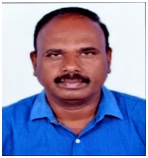
Academic Qualification : M.Sc (Agri), Ph.D
Area of Specialization : Weed management, Precision farming, Natural resource management
Date of joining duty at UAS, Bangalore : 14-03-2007
Date of Joining Scheme /Unit : 28-09-2018
drylandgkvk@uasbangalore.edu.in
mudal68@yahoo.com
91-9632067656
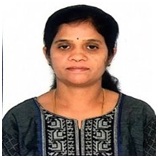
Academic Qualification : M.Sc (Agri), Ph.D
Area of Specialization: Soil fertility and nutrient management
Date of joining duty at UAS, Bangalore : 28-03-2007
Date of Joining Scheme /Unit : 31-01-2018
drylandgkvk@uasbangalore.edu.in
vasubgkvk@gmail.com
91-9986989269
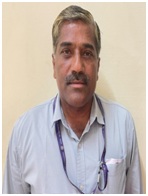
Academic Qualification : M. Sc (Agri in SWC Engg), Ph.D.
Area of Specialization : Soil and Water Conservation
Date of joining duty at UAS, Bangalore : 07-10-2013
Date of Joining Scheme /Unit : 07-10-2013
drylandgkvk@uasbangalore.edu.in
devarajaanuradha@gmail.com
91-7411957368

Academic Qualification : M. Sc (Agri), Ph.D
Area of Specialization : Integrated Nutrient Management, Organic farming
Date of joining duty at UAS, Bangalore : 20.02.2018
Date of Joining Scheme /Unit :15-07-2022
drylandgkvk@uasbangalore.edu.in
roopa229@rediffmail.com
91-8747022838

Academic Qualification : M. Sc (Agri), Ph.D
Area of Specialization : Cropping system, Organic farming
Date of joining duty at UAS, Bangalore : 23-03-2018
Date of Joining Scheme /Unit : 24-01-2021
drylandgkvk@uasbangalore.edu.in
lathahs@gmail.com
91-8197995325
Technical staff :
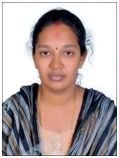
Academic Qualification : M. Sc (Agri)
Area of Specialization : Agricultural Statistics
Date of joining duty at UAS, Bangalore: 27.03.2014
Date of Joining Scheme/Unit : 01-04-2018
drylandgkvk@uasbangalore.edu.in
91-7259046146
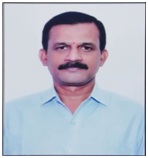
Academic Qualification : B.Com, DISM
Area of Specialization : Computer science
Date of joining duty at UAS, Bangalore : 19-01-2011
Date of Joining Scheme/Unit : 10-07-2020
drylandgkvk@uasbangalore.edu.in
shyamasundarkr@gmail.com
91-9481828190
Supporting staff:
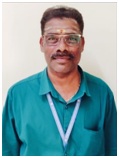
Academic Qualification : SSLC
Date of joining duty at UAS, Bangalore : 01-05-1995
Date of Joining Scheme/Unit : 03-06-2011
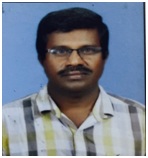
Academic Qualification : JOC with PUC
Date of joining duty at UAS, Bangalore : 06-07-2013
Date of Joining Scheme/Unit : 10-08-2022
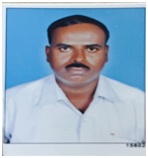
Academic Qualification : PUC
Date of joining duty at UAS, Bangalore : 01-07-2013
Date of Joining Scheme/Unit : 30-07-2021
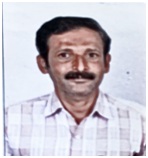
Academic Qualification : PUC
Date of joining duty at UAS, Bangalore 29-06-2013
Date of Joining Scheme/Unit : 11-07-2019
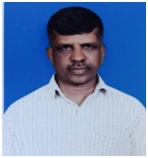
Academic Qualification : SSLC
Date of joining duty at UAS, Bangalore : 04-10-2000
Date of Joining Scheme/Unit : 01-04-2015
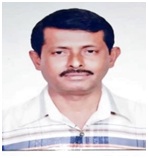
Academic Qualification : SSLC
Date of joining duty at UAS, Bangalore : 11-09-2019
Date of Joining Scheme/Unit :13-07-2021
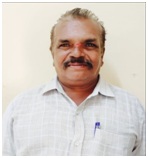
Academic Qualification : 7th
Date of joining duty at UAS, Bangalore : 06-06-1993
Date of Joining Scheme/Unit : 12-11-2007
-
- Page Visitors Count:
- Last Updated: March 19, 2025
- Site Statistics
